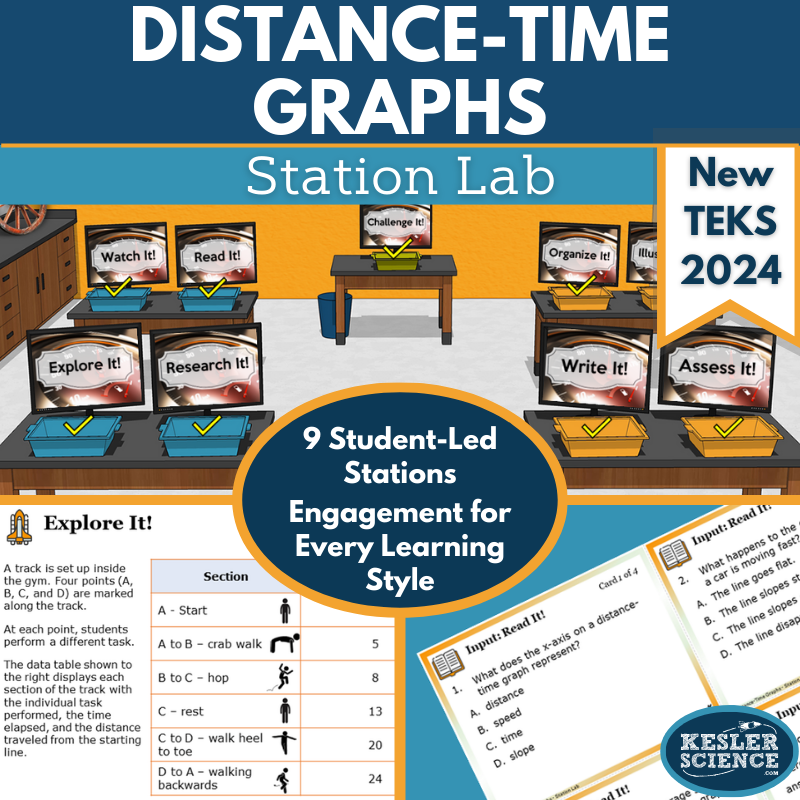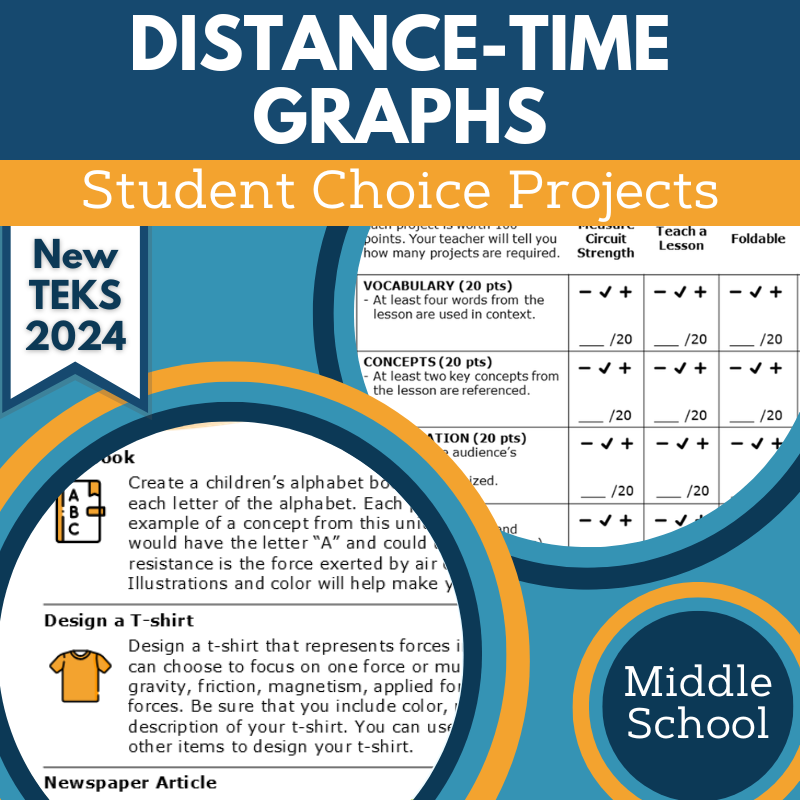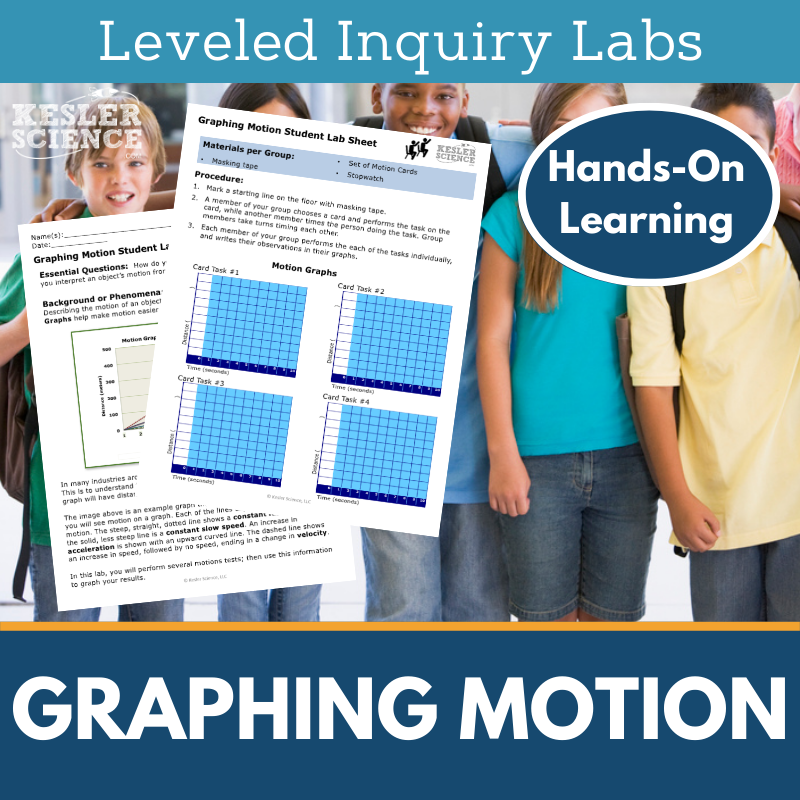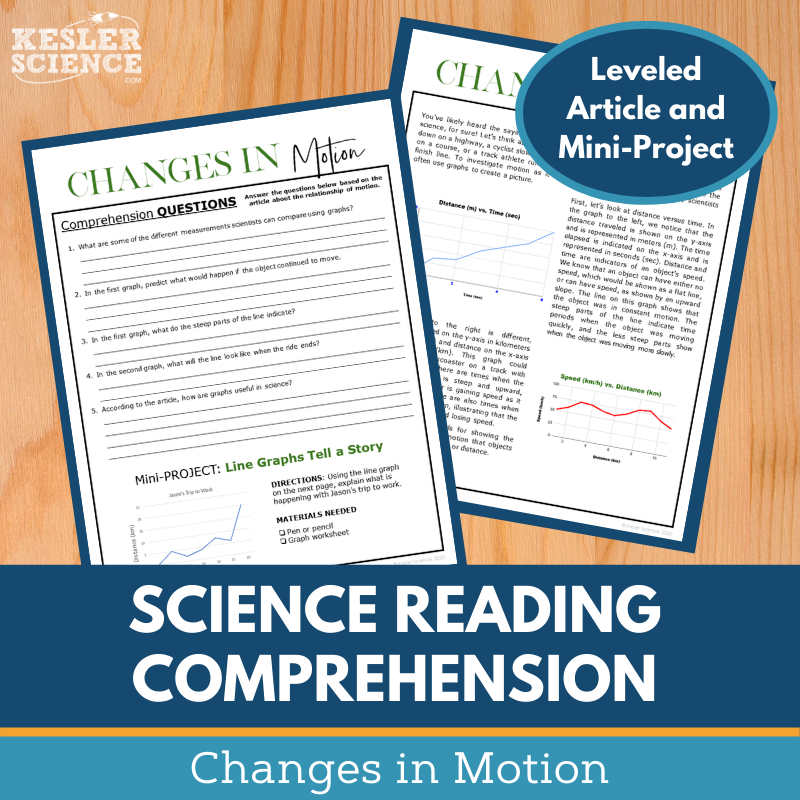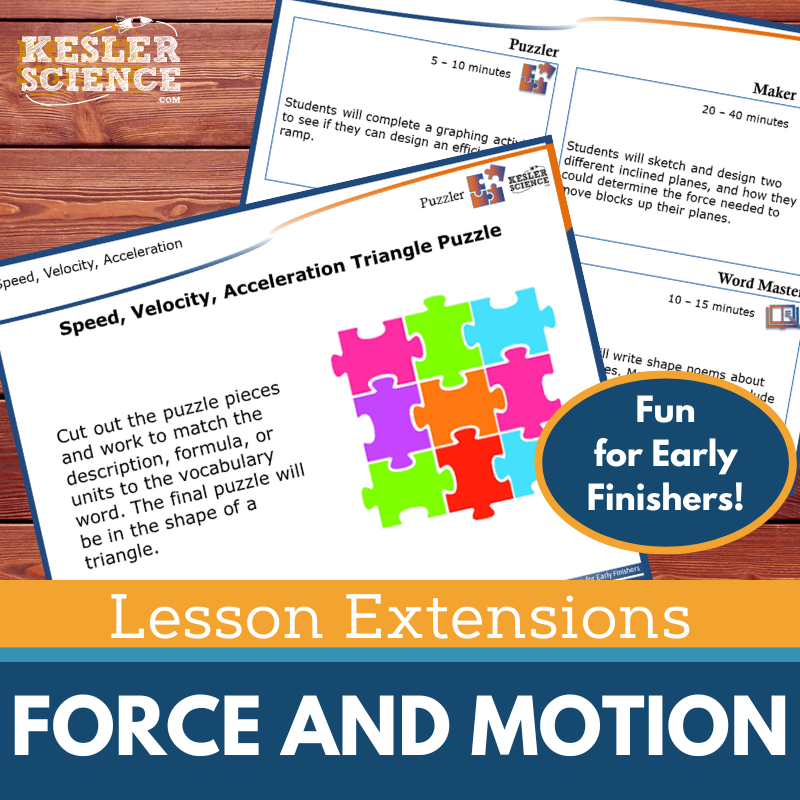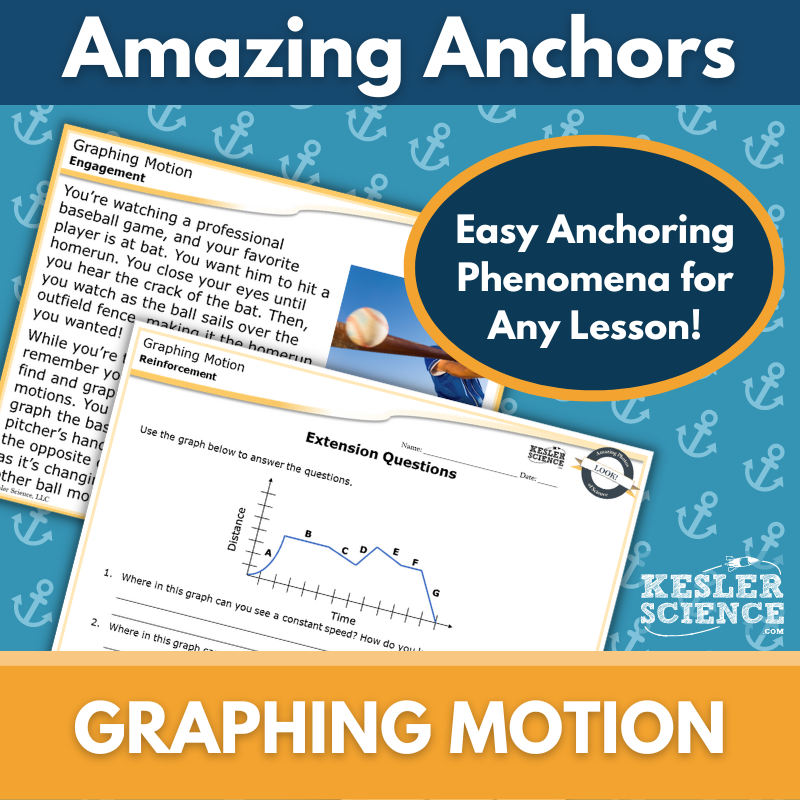Distance-Time Graphs Activities for Middle School Science
Mastering distance-time graphs is essential for understanding motion, and this engaging 5E lesson provides students with the tools to measure, record, and interpret movement effectively. Available in digital and print formats, this lesson ensures all students can successfully analyze and construct distance-time graphs. All of the following materials are also included in the Kesler Science Membership.
The Kesler Science Distance-Time Graphs 5E Lesson provides a comprehensive, engaging unit on measuring, recording, and interpreting an object's motion using distance-time graphs. It includes editable presentations, worksheets, choice projects, and assessments designed for differentiated, student-led learning. The lesson aligns with TEKS 7.7C and is available in both digital and printable formats, with Spanish translations for key materials.
Following the 5E Model, the lesson begins with engaging discussion activities and vocabulary support. The exploration phase features a differentiated, student-led station lab with nine multimodal stations, including hands-on experiments, reading passages, videos, research activities, categorization exercises, writing prompts, and illustrations. A bonus extension station challenges advanced learners.
The explanation phase includes editable PowerPoints, interactive notebooks, and structured note-taking templates. Students extend their learning through choice projects on measuring and graphing motion. Evaluation includes STAAR 2.0-aligned assessments, review worksheets, and discussion questions.
Designed for maximum flexibility, the lesson supports both in-class and virtual learning, ensuring all students can successfully interpret and construct distance-time graphs.
The Kesler Science Distance-Time Graphs 5E Lesson provides a comprehensive, engaging unit on measuring, recording, and interpreting an object's motion using distance-time graphs. It includes editable presentations, worksheets, choice projects, and assessments designed for differentiated, student-led learning. The lesson aligns with TEKS 7.7C and is available in both digital and printable formats, with Spanish translations for key materials.
Following the 5E Model, the lesson begins with engaging discussion activities and vocabulary support. The exploration phase features a differentiated, student-led station lab with nine multimodal stations, including hands-on experiments, reading passages, videos, research activities, categorization exercises, writing prompts, and illustrations. A bonus extension station challenges advanced learners.
The explanation phase includes editable PowerPoints, interactive notebooks, and structured note-taking templates. Students extend their learning through choice projects on measuring and graphing motion. Evaluation includes STAAR 2.0-aligned assessments, review worksheets, and discussion questions.
Designed for maximum flexibility, the lesson supports both in-class and virtual learning, ensuring all students can successfully interpret and construct distance-time graphs.
Engage your middle school students with this student-led station lab aligned with TEKS 2021 standard 7.7C. This interactive lesson guides students in measuring, recording, and interpreting an object's motion using distance-time graphs while promoting independent learning and critical thinking.
The lab features nine differentiated stations, allowing students to explore concepts through various modalities. Input stations introduce key ideas through hands-on exploration, video analysis, reading comprehension, and research activities. Output stations enable students to demonstrate understanding by organizing information, illustrating models, writing responses, and completing assessments. A bonus challenge station offers extension activities for advanced learners.
This flexible resource supports both in-class and virtual learning, providing a dynamic and engaging experience that encourages student autonomy.
Engage your middle school students with this student-led station lab aligned with TEKS 2021 standard 7.7C. This interactive lesson guides students in measuring, recording, and interpreting an object's motion using distance-time graphs while promoting independent learning and critical thinking.
The lab features nine differentiated stations, allowing students to explore concepts through various modalities. Input stations introduce key ideas through hands-on exploration, video analysis, reading comprehension, and research activities. Output stations enable students to demonstrate understanding by organizing information, illustrating models, writing responses, and completing assessments. A bonus challenge station offers extension activities for advanced learners.
This flexible resource supports both in-class and virtual learning, providing a dynamic and engaging experience that encourages student autonomy.
The Distance-Time Graphs Student Choice Projects align with the 2021 TEKS standard 7.7C, offering middle school students a variety of project options to demonstrate their understanding. A project page outlines six student-led choices plus a “design your own” project, all supported by an editable rubric for teacher, peer, or self-assessment.
These flexible, multimodal projects allow students to showcase their learning in creative ways. Two versions of the project page provide differentiation, with modified options for students needing remediation and challenge opportunities for advanced learners. Teachers can adjust the rubric to fit their grading needs.
The projects require standard classroom supplies like paper, markers, and scissors, with many options available for digital completion.
The Distance-Time Graphs Student Choice Projects align with the 2021 TEKS standard 7.7C, offering middle school students a variety of project options to demonstrate their understanding. A project page outlines six student-led choices plus a “design your own” project, all supported by an editable rubric for teacher, peer, or self-assessment.
These flexible, multimodal projects allow students to showcase their learning in creative ways. Two versions of the project page provide differentiation, with modified options for students needing remediation and challenge opportunities for advanced learners. Teachers can adjust the rubric to fit their grading needs.
The projects require standard classroom supplies like paper, markers, and scissors, with many options available for digital completion.
The Motion Graphing Inquiry Lab aligns with TEKS, guiding students in measuring and graphing changes in motion. Students will analyze motion by graphing different tests, using laminated motion cards in most groups, while the Independent Lab group creates their own.
This resource includes three differentiated labs to support all learners. The Dependent Student Lab combines procedural instructions with inquiry questions for guided learning. The Modified Student Lab provides a structured experience with sentence stems and multiple-choice questions for students needing more support. The Independent Student Lab encourages student-led exploration with minimal guidance, making it ideal for advanced learners.
The resource includes teacher pages with preparation details, standards, directions, materials, and additional resources. Editable reflection questions help students develop claim, evidence, and reasoning statements. Suggested answer keys simplify grading.
Materials needed include masking tape, a stopwatch, motion cards, and pencils, ensuring an engaging, hands-on experience.
The Motion Graphing Inquiry Lab aligns with TEKS, guiding students in measuring and graphing changes in motion. Students will analyze motion by graphing different tests, using laminated motion cards in most groups, while the Independent Lab group creates their own.
This resource includes three differentiated labs to support all learners. The Dependent Student Lab combines procedural instructions with inquiry questions for guided learning. The Modified Student Lab provides a structured experience with sentence stems and multiple-choice questions for students needing more support. The Independent Student Lab encourages student-led exploration with minimal guidance, making it ideal for advanced learners.
The resource includes teacher pages with preparation details, standards, directions, materials, and additional resources. Editable reflection questions help students develop claim, evidence, and reasoning statements. Suggested answer keys simplify grading.
Materials needed include masking tape, a stopwatch, motion cards, and pencils, ensuring an engaging, hands-on experience.
This Science Reading Comprehension Lesson helps students measure and graph changes in motion through a nonfiction article, comprehension questions, and a creative story based on changes in a line graph. Designed for middle school students (grades 6-8, with higher-level 5th graders), the leveled passage supports science literacy and reading comprehension.
The resource includes two Lexile-leveled articles (1100-1300), five to seven comprehension questions, a hands-on mini-project, and a Cornell notes template. Engaging, colorful graphics can be printed in grayscale.
Ideal for sub plans, ISS, extra credit, or whole-class instruction, this resource fosters critical thinking, classroom discussions, and textual analysis. It is compatible with virtual learning platforms like Google Classroom, MS Teams, Schoology, and Canvas, allowing students to complete assignments digitally.
This Science Reading Comprehension Lesson helps students measure and graph changes in motion through a nonfiction article, comprehension questions, and a creative story based on changes in a line graph. Designed for middle school students (grades 6-8, with higher-level 5th graders), the leveled passage supports science literacy and reading comprehension.
The resource includes two Lexile-leveled articles (1100-1300), five to seven comprehension questions, a hands-on mini-project, and a Cornell notes template. Engaging, colorful graphics can be printed in grayscale.
Ideal for sub plans, ISS, extra credit, or whole-class instruction, this resource fosters critical thinking, classroom discussions, and textual analysis. It is compatible with virtual learning platforms like Google Classroom, MS Teams, Schoology, and Canvas, allowing students to complete assignments digitally.
The Graphing Motion Science Writing Prompt Activity engages middle school students in a creative narrative exercise to reinforce their understanding of measuring and graphing changes in motion. Aligned with TEKS, this student-centered, low-prep resource supports both in-person and virtual learning.
This activity includes teacher directions with an answer guide, project ideas, and rubrics, along with projection and print handouts in both full-sized and half-sheet formats. A digital interactive version is also provided in PowerPoint, easily adaptable for Google Slides. Ideal for cross-curricular activities, pre-test assessments, student choice projects, early finisher tasks, extra credit, make-up work, TELPAS samples, and differentiation, this writing prompt fosters engagement and science literacy while offering flexible implementation in the classroom.
The Graphing Motion Science Writing Prompt Activity engages middle school students in a creative narrative exercise to reinforce their understanding of measuring and graphing changes in motion. Aligned with TEKS, this student-centered, low-prep resource supports both in-person and virtual learning.
This activity includes teacher directions with an answer guide, project ideas, and rubrics, along with projection and print handouts in both full-sized and half-sheet formats. A digital interactive version is also provided in PowerPoint, easily adaptable for Google Slides. Ideal for cross-curricular activities, pre-test assessments, student choice projects, early finisher tasks, extra credit, make-up work, TELPAS samples, and differentiation, this writing prompt fosters engagement and science literacy while offering flexible implementation in the classroom.
The WIKI Tickets© Formative Assessments provide engaging and flexible ways to check student understanding in 6th-8th grade science. The Force and Motion set includes 14 assessments, each available in five formats: a full-screen projection version, three printable handouts, and an interactive digital version compatible with PowerPoint and Google Slides.
Aligned with NGSS and TEKS standards, these assessments cover key topics such as calculating speed, unbalanced forces, graphing motion, gravity and mass, inclined planes, invisible forces, Newton’s laws, velocity, and acceleration. Some topics include multiple assessments, ensuring comprehensive coverage. A table of contents file is included to show alignment with standards.
WIKI Tickets© can be used as exit tickets, bellringers, or quick checks in both in-person and virtual learning settings. Students can respond on printed handouts, their own paper, or digital copies. These versatile assessments provide an effective way to gauge student progress throughout the learning process.
The WIKI Tickets© Formative Assessments provide engaging and flexible ways to check student understanding in 6th-8th grade science. The Force and Motion set includes 14 assessments, each available in five formats: a full-screen projection version, three printable handouts, and an interactive digital version compatible with PowerPoint and Google Slides.
Aligned with NGSS and TEKS standards, these assessments cover key topics such as calculating speed, unbalanced forces, graphing motion, gravity and mass, inclined planes, invisible forces, Newton’s laws, velocity, and acceleration. Some topics include multiple assessments, ensuring comprehensive coverage. A table of contents file is included to show alignment with standards.
WIKI Tickets© can be used as exit tickets, bellringers, or quick checks in both in-person and virtual learning settings. Students can respond on printed handouts, their own paper, or digital copies. These versatile assessments provide an effective way to gauge student progress throughout the learning process.
Lesson Extensions provide engaging, student-choice activities designed to challenge early finishers and deepen their understanding of force and motion concepts. These activities help fill downtime, reinforce critical thinking, and keep students engaged with rigorous yet enjoyable learning opportunities. Aligned to NGSS and TEKS standards, they offer high-level enrichment for independent learners.
Each extension includes four interactive components: Puzzler for problem-solving, Maker Space for hands-on STEAM activities, Tech Connection for digital demonstrations, and Word Master for creative writing. With teacher directions, answer keys, and both print and projection versions, these extensions are perfect for lesson wrap-ups, enrichment, or independent challenges.
Topics covered include electromagnetic forces, graphing motion, gravity, inclined planes, Newton’s laws, speed, velocity, acceleration, unbalanced forces, and the relationship between force and mass. These engaging activities ensure students remain challenged while reinforcing key physics concepts.
Lesson Extensions provide engaging, student-choice activities designed to challenge early finishers and deepen their understanding of force and motion concepts. These activities help fill downtime, reinforce critical thinking, and keep students engaged with rigorous yet enjoyable learning opportunities. Aligned to NGSS and TEKS standards, they offer high-level enrichment for independent learners.
Each extension includes four interactive components: Puzzler for problem-solving, Maker Space for hands-on STEAM activities, Tech Connection for digital demonstrations, and Word Master for creative writing. With teacher directions, answer keys, and both print and projection versions, these extensions are perfect for lesson wrap-ups, enrichment, or independent challenges.
Topics covered include electromagnetic forces, graphing motion, gravity, inclined planes, Newton’s laws, speed, velocity, acceleration, unbalanced forces, and the relationship between force and mass. These engaging activities ensure students remain challenged while reinforcing key physics concepts.
This Amazing Anchors Phenomenon Lesson engages students in graphing motion through the real-world example of a baseball game. It begins with an introductory reading that explores the motion of a ball, followed by comprehension and extension questions to prepare students for deeper learning. An explanatory reading then breaks down the science behind graphing motion, with additional questions to reinforce understanding.
Aligned with TEKS, this no-prep resource includes teacher directions, answer keys, projection slides, and both print and digital formats for easy integration into any classroom. A modified version with sentence starters supports differentiated learning. Designed to bookend a lesson, these readings serve as engaging supplements to reinforce motion graphing concepts.
This Amazing Anchors Phenomenon Lesson engages students in graphing motion through the real-world example of a baseball game. It begins with an introductory reading that explores the motion of a ball, followed by comprehension and extension questions to prepare students for deeper learning. An explanatory reading then breaks down the science behind graphing motion, with additional questions to reinforce understanding.
Aligned with TEKS, this no-prep resource includes teacher directions, answer keys, projection slides, and both print and digital formats for easy integration into any classroom. A modified version with sentence starters supports differentiated learning. Designed to bookend a lesson, these readings serve as engaging supplements to reinforce motion graphing concepts.
Year-Round Resources
These year-round activities will increase your students' understanding of many middle school science topics. All of these activities are also included in the Kesler Science Membership.
Visual Data & Graphing
You're not alone if your students struggle with understanding graphs, charts, and tables. It's a skill that takes an enormous amount of practice. This resource will help students build a strong foundation in analyzing data and creating their own data visualizations.
Bell Ringers and Warm-Ups
These middle school science bell ringers are an excellent way to engage your students as soon as they walk into your classroom. This comprehensive FULL YEAR resource includes everything you need to start off each science class with an interesting warm-up activity.
Review Board Games
Each game board has been carefully designed to keep students engaged. There are 10 different action spaces on each board and dozens of question cards. All of the actions are related to science concepts and keep the students motivated throughout the game.
Each game is ready to play. Simply print out the board and the cards and let the students enjoy reviewing nine different units.
Essential Questions and Standards
Below are the essential questions and standards associated with the lessons and activities included in the atoms unit. This topic is only one of more than 100 middle school science topics included in the Kesler Science Membership.
-
How do we measure and record an object’s motion using distance-time graphs?
-
How can we use a distance-time graph to interpret an object’s motion?
-
TEKS Science - 7.7C Distance-Time Graphs
Kesler Science Membership
Imagine never having to search for another middle school science lesson again. The membership gives you access to ALL of the Kesler Science products in one place (Yes, including everything above).
Say goodbye to long hours of lesson prep.



